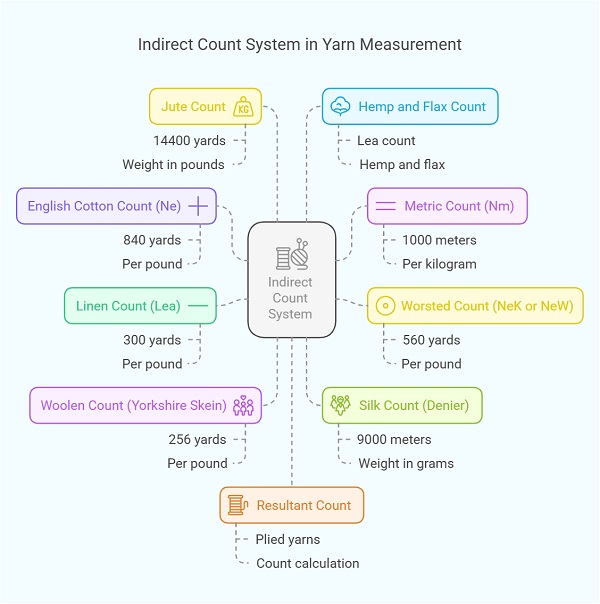Indirect Count System
The Formula for Indirect Count System Calculator
Indirect Count=Length of Yarn (meters) ÷ Weight of Yarn (grams)
Where:
- Indirect Count = The count of the yarn based on length per unit weight
- Length of Yarn = The total length of the yarn in meters
- Weight of Yarn = The total weight of the yarn in grams
Table of Contents
What is the Indirect Count System?
The indirect count system is used to measure yarn thickness based on length per unit weight. A higher count means finer yarn, and a lower count means coarser yarn. This system is common in cotton, wool, silk, jute, and flax industries.

Types of Indirect Yarn Counts
Different industries use specific units for measuring yarn count. Below are the primary count systems used:
1. English Cotton Count (Ne)
- Used for cotton yarn.
- Defined as the number of 840-yard hanks per pound of yarn.
- Formula:
Ne = (Length in yards) / (Weight in pounds × 840)
2. Metric Count (Nm)
- Used for various fibers, including wool and synthetics.
- Defined as the number of 1000-meter lengths per kilogram of yarn.
- Formula:
Nm = (Length in meters) / (Weight in kilograms × 1000)
3. Worsted Count (NeK or NeW)
- Used for worsted wool yarn.
- Defined as the number of 560-yard hanks per pound.
- Formula:
NeK = (Length in yards) / (Weight in pounds × 560)
4. Linen Count (Lea)
- Used for linen yarn.
- Defined as the number of 300-yard hanks per pound.
- Formula:
Lea = (Length in yards) / (Weight in pounds × 300)
5. Woolen Count (Yorkshire Skein)
- Used for woolen yarn.
- Defined as the number of 256-yard hanks per pound.
- Formula:
Yorkshire Skein = (Length in yards) / (Weight in pounds × 256)
6. Silk Count (Denier for Filament Silk)
- Used for filament silk.
- Defined as the weight in grams of 9000 meters of yarn.
- Formula:
Denier = (Weight in grams × 9000) / Length in meters
7. Jute Count (lbs per Spindle)
- Used for jute yarn.
- Defined as the weight in pounds of 14400 yards of yarn.
- Formula:
Jute Count = (Weight in pounds × 14400) / Length in yards
8. Hemp Count and Flax Count
- Similar to linen count but applied to hemp and flax fibers.
- Formula follows the Lea count system.
9. Resultant Count (for Plied Yarns)
- Used for multiple twisted yarns.
- Formula:
Resultant Count = 1 / (1/Ne1 + 1/Ne2 + 1/Ne3 + ...)
How to Use the Indirect Count System Calculator
- Select the type of yarn count from the list (Ne, Nm, NeK, etc.).
- Enter the yarn length in yards or meters.
- Input the weight in pounds, kilograms, or grams.
- Click ‘Calculate’ to get the yarn count.
- The result will show the yarn count in the selected system.

Why is Yarn Count Important?
- Determines the fineness of yarn.
- Helps in fabric weight calculation.
- Ensures consistency in textile production.
- Essential for selecting yarn for knitting or weaving.
Conversion Between Different Count Systems
Since various count systems are used worldwide, conversion formulas help in comparing yarns:
- Ne to Nm: Nm = Ne × 1.693
- Nm to Ne: Ne = Nm / 1.693
- NeK to Nm: Nm = NeK × 1.69
- Denier to Nm: Nm = 9000 / Denier
Conclusion
The indirect count system helps classify yarn thickness based on length and weight. Using an Indirect Count System Calculator simplifies the process of determining English Cotton Count (Ne), Metric Count (Nm), Worsted Count (NeK), Linen Count (Lea), and more. By applying the correct formulas, manufacturers and textile professionals can maintain precision in yarn selection and quality control.